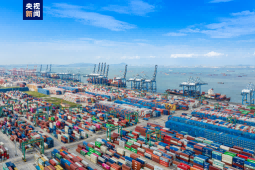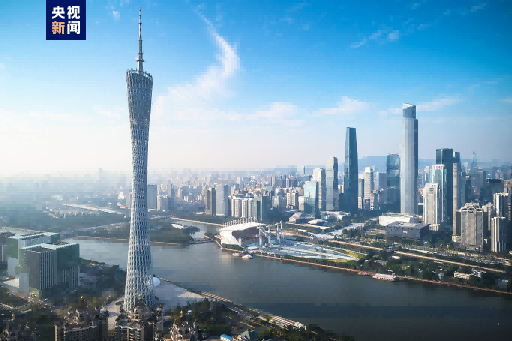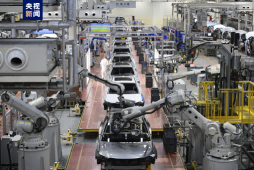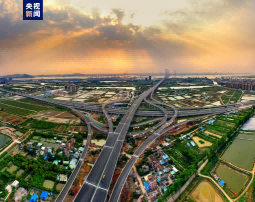How to see from afar and see the "new spatial concept" of Guangdong's development through deep travel
Party and government officials led teams and organized visiting delegations to conduct intensive overseas inspections... Recently, there has been a trend of "inspection" in various parts of Guangdong: the destination of the visit includes not only Guangdong's traditional "old friends" in Europe and other economic and trade traditions, but also emerging markets with huge potential in East Asia and Southeast Asia.
At the same time, taking advantage of the opportunity of the China International Fair for Trade in Services held in Beijing, the Guangdong delegation, together with 74 enterprises, made a collective appearance, seizing the opportunity to showcase the charm of Guangdong's service trade to the world and expand new opportunities for cooperation.
Internal and external cooperation, Guangdong is constantly moving forward. In a hurry, it reveals the urgency to seek a "new market", and coincidentally reflects the consensus to expand the "new space" - as a major foreign trade province in China, Guangdong's dependence on foreign trade has been maintained at over 60% in recent years. However, with the complexity and variability of the global economy and the continuous weakening of external demand, Guangdong is also facing enormous pressure from shrinking demand, supply shocks, and weakened expectations. The pressure on the storm has increased dramatically, and the challenge of guarding the "South Gate" is unprecedented.
At the same time, as the "largest province in the economy", Guangdong bears an important responsibility to contribute to the stability of the country through its own "progress", and the whole country has a new expectation for Guangdong to continue to be the first to break through.
General Secretary pointed out, "Guangdong's reform and development will take a step forward, and the sense of necessity and urgency in promoting high-quality development will be deeper."
Those who walk deep see far. At this important juncture in promoting changes in development mode, driving force, field, and quality, Guangdong has shifted from being accustomed to sailing on a downwind ship to being adept at sailing on a top wind ship in the face of the complex international situation. To sit firmly on the fishing platform, one cannot let the wind and waves rise.
I can't sit still, let alone wait. Today, Guangdong, which is anchored at the forefront of the overall goal, proposes to "rebuild a new Guangdong". How will it shape a new space for development?
Why seek opportunities in times of danger when expanding outward?

Don't walk early, there are even early pedestrians.
At the end of last year, Guangdong rushed to seize the opportunity and cooperated with government and enterprises. Entrepreneurs successfully formed groups and chartered planes to go abroad, exchanging time for space. Guangdong took the lead in allowing orders from around the world to flow into the "World Factory".
Upon careful analysis of the new round of "overseas visits", not only are there enterprises, but also local officials, and the theme has undergone profound changes: in addition to deepening cooperation in traditional industries, government officials are also exploring more emerging and future industries, seeking new cooperation with the most advanced local industrial chains, and seizing future space in emerging fields.
In the past, Guangdong achieved quantitative and qualitative growth by deeply participating in international division of labor and integrating into the international circulation. At the same time, it has also formed a development reality of high trade dependence.
Dependence cannot further evolve into dependence. In order for Guangdong to continue consolidating and expanding its advantages in the two cycles, it must continue to "dare to be the first".
From "grabbing orders" to "grabbing space", it is precisely behind Guangdong's strategic consideration to further expand the depth of its external economy.
This profound meaning can be traced back: since the end of last year, stabilizing foreign investment and trade has become a "strong signal" released by multiple important conferences in Guangdong. The second plenary session of the 13th Guangdong Provincial Party Committee proposed for the first time to optimize the layout of opening up to the outside world, and to play a good combination of "five external linkage" in foreign trade, foreign investment, outsourcing, foreign economy, and foreign intelligence; At the provincial high-quality development conference held in the first session of the Chinese New Year at the beginning of the year, Guangdong focused on high-quality development and clarified that "reform and opening up are the most distinctive characteristics of Guangdong"; The Third Plenary Session of the 13th Guangdong Provincial Party Committee clearly defined "openness" as one of the "three major driving forces" that must be vigorously activated.
Focusing on the new situation of foreign trade, Guangdong has proactively implemented more open policies, relaxed market access restrictions for foreign trade enterprises, lowered tariffs and trade barriers, and frequently introduced new tactics to help enterprises enhance their long-term competitiveness. To test the results brought about by a series of measures, we can find the answer from the transcript of China's total foreign trade value in the first half of the year - in the total foreign trade value of 31 provinces and cities in the first half of this year, Guangdong's foreign trade import and export scored a "high score" of 3.86 trillion yuan, surpassing the second ranked province in the country by more than 100 billion yuan, far ahead of other provinces nationwide.

Looking at the spatial perspective of Guangdong's economy: in the balance of danger and opportunity, stability and progress, and attack and defense, the open thinking of "expanding the pattern and extending space" has become increasingly clear.
Break through upwards
How can "top students" rebuild their advantages?
Starting from the manufacturing industry, to becoming the leader of the manufacturing industry. This is not only a clear summary of Guangdong's development experience since the reform and opening up, but also a solemn choice on how to continue to maintain development advantages in the new era.
In 2022, the total added value of Guangdong's manufacturing industry reached 4.4 trillion yuan, accounting for more than one eighth of the national total. The manufacturing industry has become a strong "asset" in Guangdong. In the first half of this year, industrial investment in Guangdong increased by 23.3%. Among them, investment in manufacturing increased by 18.2%.
How to maintain this foundation and create greater entrepreneurial space for industrial investors? Guangdong's manufacturing industry not only needs to continue to stand firm, but also needs to continue to explore the development space of the manufacturing industry with the help of "top students breaking through".
Recently, two news reports in Zhongshan, Guangdong have attracted attention: firstly, the renovation and upgrading area of the local inefficient industrial park has exceeded 22000 acres, with an average daily clearance of nearly 40 acres; The second is that two manufacturing projects in the local Torch Development Zone achieved "land acquisition and construction start" on the same day.
Behind the "Zhongshan speed" lies a clear understanding of the development space of the manufacturing industry.

In the local area, this inefficient industrial park renovation work is vividly referred to as the "spatial revolution". This also highlights the difficulty of local industrial reform - inefficient industrial parks have made contributions to urban development in the past, but now they continue to produce low efficiency and occupy the development space of emerging manufacturing industries. Demolition of old parks also involves complex historical legacy and multiple interests.
It is easy to demolish old factory areas, but difficult to break through the inertia in the heart.
Zhongshan, which ranks second to last in terms of land area in the province, has a development intensity of nearly 40% for construction land, and some towns and streets even have a development intensity of up to 85%. In order to reshape the new pattern of local industrial development, Zhongshan had to take the initiative to seek space through "change" with the determination of "breaking the wrist".
Since the beginning of last year, Zhongshan has officially launched this "industrial reform" campaign. Over the course of a year and a half, with government guidance, market operation, and voluntary participation from enterprises, Zhongshan has demolished a large amount of inefficient industrial land. With the support of favorable factors such as the upcoming completion and opening of the Shenzhen China Corridor and the just landing of the Shenzhen China Economic Cooperation Zone, this achievement has reserved valuable development space for the local area. Looking at Guangdong, we will vigorously implement the "big platform" promotion action, actively create a number of "tens of thousands of acres and billions of yuan" park carriers, deepen the cultivation of characteristic industrial parks, promote the upgrading and transformation of rural industrial clusters, and comprehensively promote the high-quality development of industrial park economy.
Shenzhen, which faces Zhongshan across the river, has an equally urgent demand for industrial space.
Empowering the development of high-quality manufacturing, Shenzhen chooses to look upwards.
Not long ago, China's first fully assembled "industrial upstairs" project - the first phase of Shenzhen Pingshan New Energy Vehicle Industrial Park was completed and put into use in Shenzhen.
The so-called "industrial upstairs" refers to multi story factories or "skyscraper factories". In Shenzhen, where land resources are very precious and limited, "asking for land from the sky" has opened up a new problem-solving approach.

While providing sufficient physical space for the industry, the industrial agglomeration effect brought by "industrial upgrading" also helps Shenzhen's industry to "take it to the next level".
At present, in the Guangdong Hong Kong Macao Greater Bay Area, there is a fierce competition around the manufacturing industry, focusing on the preparation of industrial space and the promotion of investment. Adapting to local conditions and actively seeking change, protecting advanced manufacturing industries like protecting farmland, is becoming a consensus and action in more and more regions.
Looking across the country, Guangdong, as a pioneer in building a strong manufacturing country, inevitably shoulders significant responsibilities in promoting high-quality development of China's manufacturing industry. In the face of increasingly severe and complex international situations, weak global manufacturing, and pressure on foreign trade growth, only by adapting to changes can we seek opportunities in times of crisis, turn crises into opportunities, and achieve stability and progress.
Requesting space from weaknesses
How to explore new avenues for regional coordination?
From the perspective of natural resources, Guangdong is a typical "seven mountains, one water, two fields" region, but its arable land resources are seriously insufficient, with per capita arable land area less than half of the national average; From economic data, mainland cities in the Pearl River Delta, together with Hong Kong and Macao, have created 12% of the country's total economic output with less than 1% of the land area. At the same time, counties with an area of 71.7% in the province only account for 12.5% of the province's GDP.
Two different levels of observation can lead to the same conclusion: Guangdong's regional development is uneven, and there is huge development space in the eastern and northwestern regions of Guangdong. The imbalance of urban-rural regional development has become the biggest shortcoming and greatest potential for high-quality development in Guangdong.
Therefore, how to achieve new breakthroughs in coordinated development between urban and rural areas directly affects whether Guangdong's economy can achieve high-quality development.

County governance ensures the peace of the world. Today, Guangdong has implemented the "High quality Development Project for Hundred Counties, Thousand Towns, and Ten Thousand Villages" to address regional development imbalances and propose to promote the "new urbanization with county towns as important carriers". How to scientifically promote the orderly transfer of industries and promote the development of counties through industry is the key breakthrough.
Observing the economic performance reports of various cities in Guangdong in the first half of the year, Jieyang has emerged as a new force: the total regional GDP of the city is 112.02 billion yuan, an increase of 7.6%, ranking first in the province in terms of growth rate. Why can this small town in eastern Guangdong make a comeback and surpass a group of central cities in the country, achieving such outstanding results in a specific industry? How can we accelerate regional collaborative development and gain an advantage in this game of seeking innovation and change?
In the past, this city with plastic products, hardware products, and textile and clothing as its main industries also had a development misconception: the days of relying on OEM and low-end manufacturing to rise were gone more than a decade ago. Where is the new industrial space?
"By 2035, Guangdong will achieve one hour access within the Guangdong Hong Kong Macao Greater Bay Area and two hours access within Guangdong Province. In terms of goods circulation, it will be delivered within one day domestically." Li Jing, Chief Planner of the Guangdong Provincial Department of Transportation, said that from the perspective of the Guangdong Hong Kong Macao Greater Bay Area, the distance between the east and west of Guangdong is constantly narrowing, and the increasingly fast transportation network has enabled Jieyang to find a new "rising password" - as Guangdong's first Chinese express delivery demonstration city. On last year's national express delivery volume list, Jieyang surprisingly surpassed three major cities: Shanghai, Hangzhou, and Dongguan, with an annual express delivery business volume of 3.729 billion pieces. Placing orders in Guangzhou and Shenzhen, and shipping from Jieyang to the world has become a reality. "Revitalizing the County with Industry" has illuminated the road of enriching the people in Qiangxian Village.
To achieve high-quality development, not a single one can be omitted. It is important to fully activate the new vitality of regional coordinated development and break through the constraints and barriers of inherent models. In addition to opening up new paths for rural economic transformation through self industrial transformation like Jieyang, there are also more ways to achieve regional win-win through regional cooperation and complementarity. Looking at the current situation, the "enclave economy" cooperation of "you come and I go" has become unstoppable in Guangdong: the Guangqing Economic Special Cooperation Zone has introduced over 600 projects, the Foshan Industrial Transfer Industrial Park is advancing at full speed, and the industrial coordinated development of the Heyuan Longchuan Science and Technology Innovation Center has entered a new stage.
Traveling towards high places and seeking further directions. Faced with the complex environment of high winds and waves, Guangdong not only has the historical mission of leading the way, but also the courage to take on the task immediately. Creating new development space, expanding more resilient economic depth, and forming more advantageous strategic initiatives, Guangdong's direction is vast!




